Repurpose Content For Social Media
You spent days, maybe weeks crafting that massive blog post, white paper, or industry trends report.
Now you spend the next few weeks promoting this content to drive social shares, backlinks as well as traffic back to your site. A few months later, that piece of content you worked so hard on is out of sight, out of mind. But who can blame you?
Creating content is a resource-intensive process that takes time, money and most often a combination of both. Promoting content takes even longer. This is especially true if you're a small team (with limited resources) and content marketing is a key component of your online marketing strategy.
So how do you produce more with less? How do you promote new and older content to drive higher ROI from your content-creation efforts? In short: how do you hack the content marketing process?
The answer? Repurpose your content! Repurposing content is not only a massive time-saver, it can breathe life into your older content and help you expand your reach by promoting it to an entirely new audience.
What does it mean to repurpose content?
You're probably muttering to yourself, "I'm with you so far but what does repurposing content even mean?" In simple words: repurposing content is taking any new or existing piece of content, repackaging it in a different format and promoting it on different platforms.
Here's an example from Julian Shapiro and how he repurposes blog content:
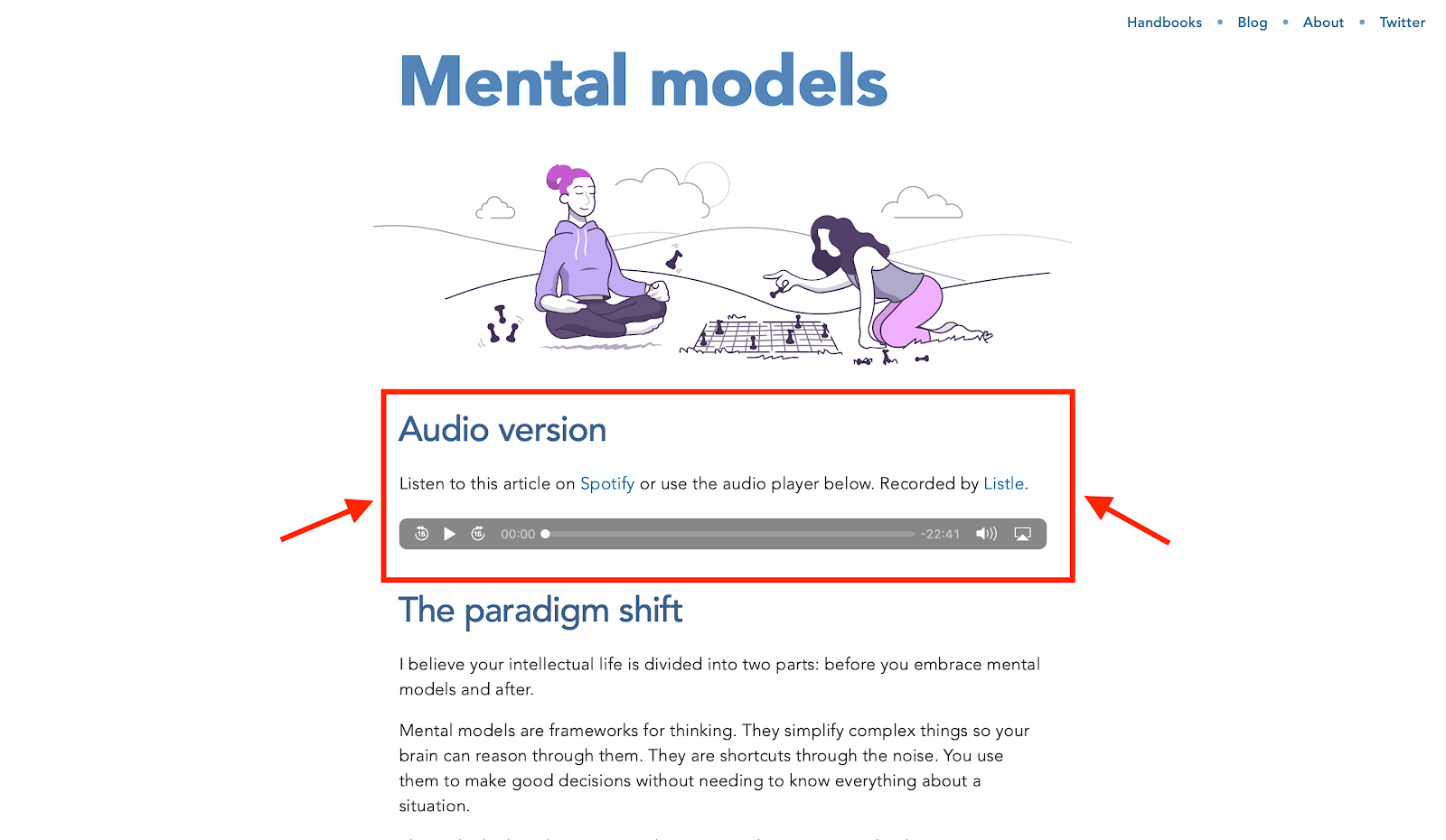
Source
Not only does Julian write in-depth and high-quality posts, he repurposes them as audio-only (or podcast) versions to appeal to both the readers and listeners in his audience. How long do you think this took him? Probably not more than a few hours.
Repurposing content is not time consuming or complicated if you know what you're doing. In this guide, we'll be showing you the what's and how's behind repurposing content (along with examples).
But why is repurposing content so important anyway? Well, content repurposing has countless benefits and little-to no downside.
Here are three benefits that immediately come to mind:
- Tap into new audiences: Not everybody consumes content the same way. Repurpose existing content so searchers can discover and consume it on their platform of choosing.
- High ROI: If content is a fire, repurposing is the fuel. If you've spent weeks on creating the best blog post, why not repurpose it and make the most of your efforts?
- 80/20 your content: You don't need to create new content day in day out. Repurposing content allows you to create less and promote more.
What kind of content can you repurpose?
This may sound cliche, but when it comes to the what's of repurposing content, the sky's the limit. You can repurpose pretty much any piece of content. Blog content, slide decks, eBooks, podcasts, whitepapers – you name it, you can repurpose it.
- Wrote a blog post? Repackage the content and present it as a webinar.
- Hosted a great online event? Use the content as a bonus lesson in your online course.
- Wrote an in-depth trends report? Visualize the data and promote it as a visually-arresting infographic.
Eric Siu, Founder and CEO of Singlegrain demonstrates that repurposing content not only works but can even help you build a new audience on a different social platform:
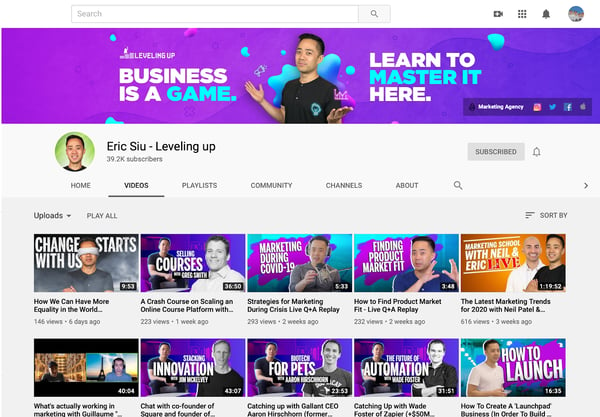
Source
Eric runs a popular podcast called Leveling Up. He uploads every episode to his YouTube channel. This helps him grow not only podcast listenership but also his YouTube subscribers. If you were looking for proof whether repurposing content works, there you have it.
8 actionable ways you can repurpose content
If you know the whats and the hows, repurposing content is no longer rocket science. Here's a simple way to get started: if you're currently creating any new skyscraper content, use this guide to find ideas on how to repurpose the same content creatively.
This not only applies to your new content. Spend some time revisiting your blog archives. Perhaps some of your older posts could perform well as social media content, eBooks or YouTube videos?
1. Repurpose blog content as slide decks
Try repurposing and uploading blog posts as slide decks on Linkedin. You can also upload and promote these slides on Slideshare for extra visibility. Ideally expert-quotes, actionable tips, or research-backed statistics would be the perfect fit for a slide deck where you restate key points or summarize important stats from your blog post.
Here's an example of how repurposed content as slide decks on Linkedin:
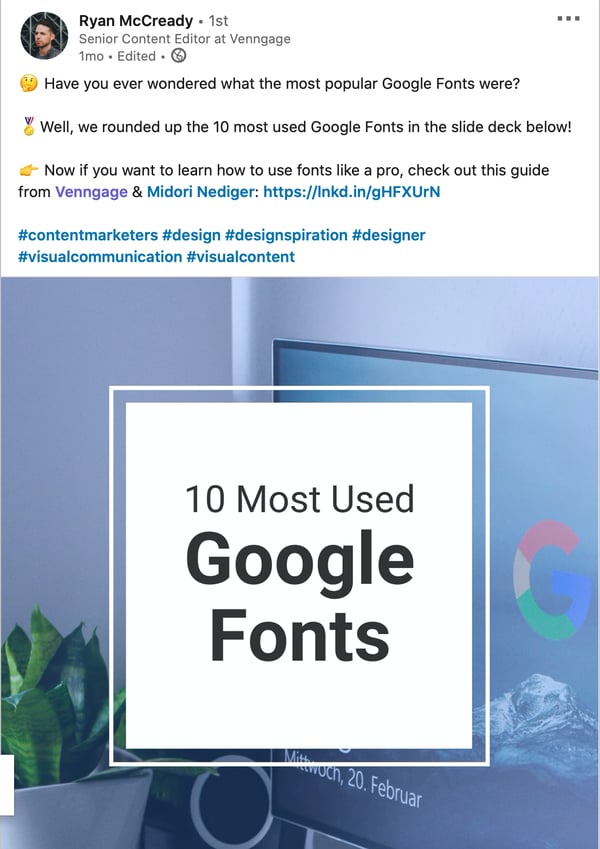
Uploading your blog posts as slide decks is yet another opportunity at driving more eyeballs to your content and subsequently boosting ROI from both your older and newer content. This means more engagement, more awareness and more traffic. And isn't this what we as content marketers want anyway?
G2 has compared some of the best presentation makers on the market. Pick your tool, start repurposing your content and uploading them as slide decks!
2. Repurposing content for social media
On the same note, you can also repurpose blog posts as social media images for promotion across different social networks. Again, this not only applies to any new content you're promoting but also for re-promoting older content that you think could deserve some more attention.
When you're creating evergreen content that stands the test of time, you can share your content today or a few months later and it'll still be relevant.
Here's what you can repurpose as social media content:
- Interesting tidbits or actionable advice
- Research-backed data or statistics
- Quotes or tips from experts
Got step-by-step actionable advice to share? Share them as a carousel posts on your Instagram. Got industry-specific insights from your research? Put it out as a digestible tweetstorm and link to your research at the end.
G2 creatively repurposed their newsjacking post and promoted it using a bite-sized expert tip:
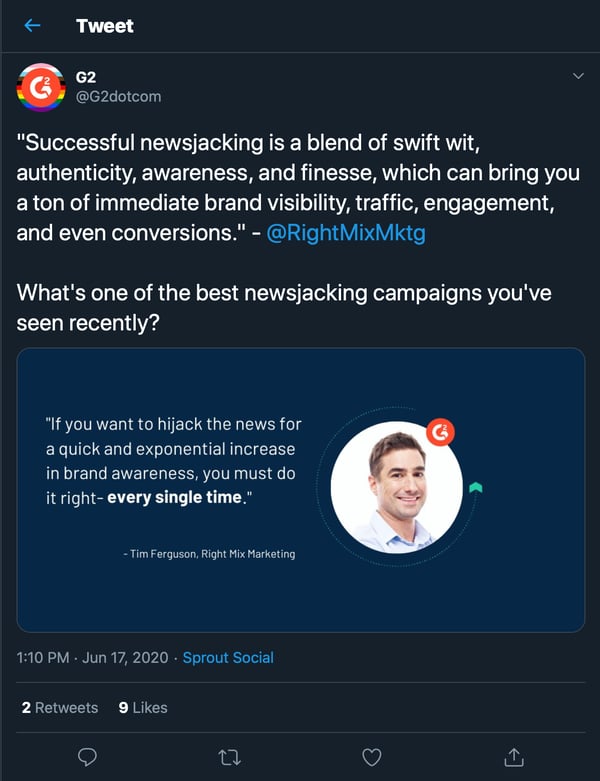
3. Convert blog posts into eBooks and downloadable PDFs
If you have multiple blog posts on the same topic, why not combine them and repurpose the content as an eBook or a downloadable PDF? If you're looking to increase leads generated from your blog, repurpose blog content as eBooks, checklists, PDFs, or DIY templates and offer them as a free content upgrade.
Hubspot does content upgrades better than most. They have plenty of eBooks, checklists, calculators as well as checklists on a wide-variety of topics:
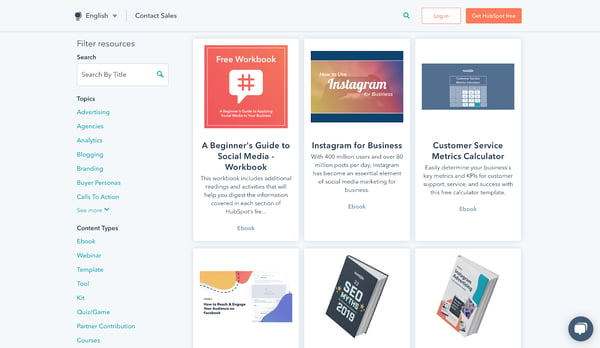
Source
This way Hubspot can increase the leads they generate by creatively repurposing existing blog content to create and offer free content upgrades.
The folks at G2 also did an amazing job at repurposing their guide on handling negative reviews into this handy flowchart-styled cheat sheet:
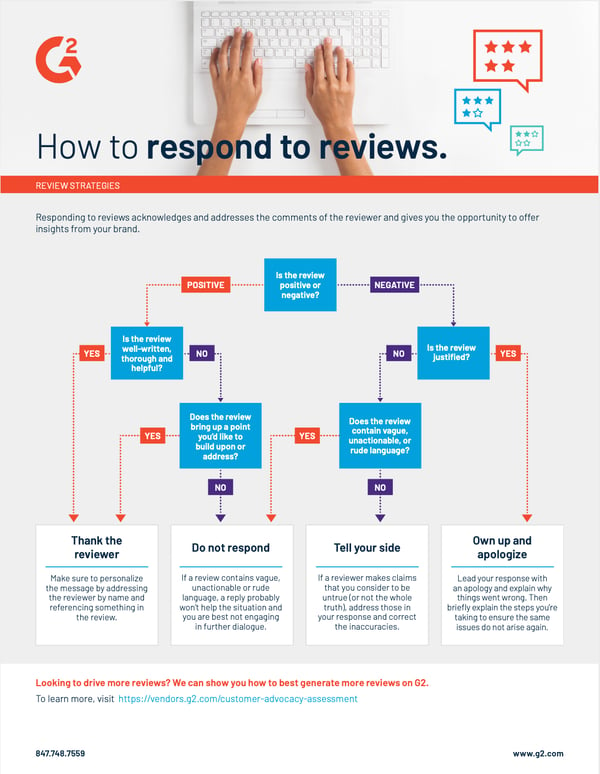
Source
4. Repurpose content as YouTube videos
If you've regularly created educational content for your blog, hosted interviews and events or recorded webinars, why not repurpose and upload them on YouTube? With the right video optimization in place, chances are your videos will not only show up on Youtube but also on Google's search results.
People have seen great success when it comes to incorporating videos into their content strategy. This has been made possible by repurposing any new or old content in video-only formats.
For example, after the popularity of this how to make an infographic guide, the content was the perfect candidate for content repurposing. As you can see, the repurposed video guide complement to the article has ~150,000 views so far:
Repurposing content like this means you can attract new blog readers, have more product sign-ups, and other upgrades from YouTube. Not only that, you're also able to appeal to searchers looking for educational videos about infographics on YouTube.
Brian Dean from Backlinko has seen breakthrough success on YouTube. He repurposes a huge chunk of his blog content into video versions. Here's his on-page seo guide published as a YouTube video:
Even as an older video, it's still driving plenty of views and playing it's part in growing Brian's YouTube subscriber base. As mentioned above, this concept can be applied to events as well. Matt Diggity's Chiang Mai SEO Conference replays for example, often end up on his YouTube channel and in his blog content.
5. Turn blog posts into webinars
Typically blog posts are meant to educate, inspire or convert readers into prospective buyers. The goal of a webinar is most often lead generation. If you've got a collection of blog content on a specific topic readers enjoy and if you're having trouble generating leads, how about repurposing that content as a conversion-focused webinar?
You can also do the reverse: reuse any current or past webinars and publish them as standalone blog posts that summarize or expand on any actionable tips from the webinars.
Webinars, blog posts, and email marketing used in conjunction can play a huge role in helping you reduce customer churn. G2 has a great hub of content centered around webinars to help you get up to speed on everything you need to know about creating and hosting your webinars.
6. Create infographics from blog content
Infographics are liked or shared three times more than other types of content. So if you're looking for a way to improve your social engagement, infographics are your best bet.
Infographics are perfect for:
- Breathing life into any new/existing piece of content you've created
- Summarizing and presenting complex information in a digestible format
- Increasing social shareability and engagement
- Boosting brand awareness and landing press mentions
A few years ago, Mention for example analysed 11 billion social media mentions. They presented their findings in a research study. But to make their study easier to digest for their audience, they repurposed their research into a handy infographic:
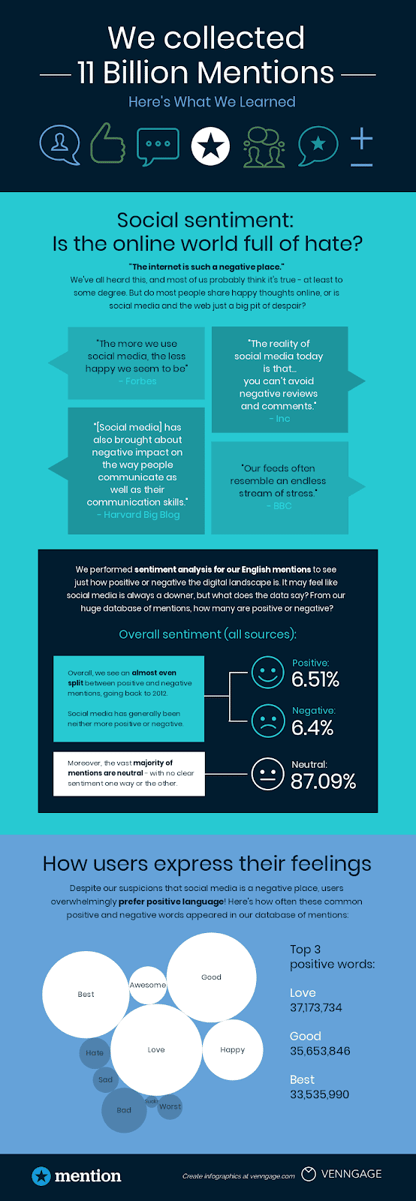
Source
Not sure where to start? Here are some ideas:
- Identify your highest-performing blog posts. Create an infographic version and include them within the blog posts.
- Revisit your blog archives. Identify some of your older posts that could use a content refresh, update the content and create an infographic to accompany it.
- Conducting original research? Summarize your findings in an infographic. This will not help boost social media sharing but can also help you land mentions in the press.
Research-driven studies and long form how-to guides in particular are perfect candidates for repurposing into an infographic.
7. Update older blog content
On that note, let's talk about the lowest hanging fruit: updating older content. Updating older content with new and up-to-date information, insights, research, and more can help bring your content back to life. "This makes outdated content relevant again and in turn, helps you rank higher on Google," says Dan Fries, founder of BlueTree.ai.
Giving your older blog posts a refresh and re-promoting it again to relevant audiences is the easiest thing you can do right now to increase organic rankings and blog traffic.
- Identify your highest-performing content. Ideally anything older than six months is a good candidate for a content refresh.
- Update evergreen content only. Evergreen content is content that always continually stays relevant for readers. Eg: "Google's Panda Algorithm" would be considered an outdated topic and doesn't qualify as evergreen content.
- Identify pieces of content that need an update. Once you've identified evergreen content older than six months, identify the most outdated content pieces that are in dire need of a refresh.
G2 is applying this concept to their "What is a CRM?" guide. Instead of having a few smaller pieces of scattered articles, they're investing time in bringing it all together in one mega guide.
Supermetrics for example, added a video case study to their SEO analytics guide. This way their guides become a much more comprehensive resource or a "one stop shop" for their readers.
8. Repurposing your blog for guest posts
If you've created a mammoth guide like the example above, why not repurpose small pieces of the guide as guest posts for other websites? Guest posting has plenty of benefits: more brand visibility, more link, and more traffic.
You've already got the content, all you need to do is:
- Identify sections in your guide that can stand on their own as guest posts.
- Identify high-authority sites accepting guest contributions in your niche.
- Pitch them your idea, write the guest post and link back to your original guide.
This piece about the latest graphic design trends has been the perfect candidate for guest blogging, as evidenced by the links below:
- CampaignMonitor
- GoSkills
- Mention
- Millo
To get started, revisit your blog archives to find content that could be repurposed into a series of guest posts. All you need to do now is the actual guest post pitching! Better yet, apply this strategy to any new viral or research-driven study you might be working on.
Takeaways
Repurposing content is the secret sauce behind companies that drive the most value from their content by breaking one piece of content into multiple formats and promoting them across multiple channels.
The research study you spent days creating can be repurposed into an eBook, slide deck or even a week's worth of social content. This not only helps you tap into a new audience but also gives your content a longer shelf life.
Bottom line? Repurposing existing content is an absolute no-brainer if you want to drive the most ROI from your content creation efforts.
Repurpose Content For Social Media
Source: https://learn.g2.com/repurposing-content
Posted by: lowewincert.blogspot.com

0 Response to "Repurpose Content For Social Media"
Post a Comment